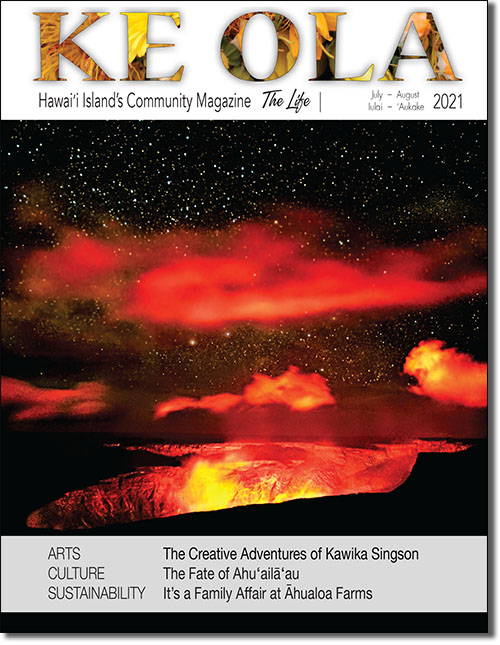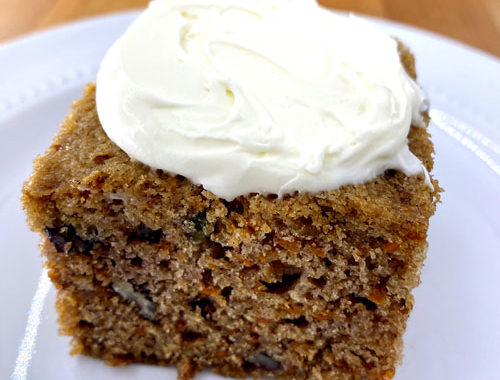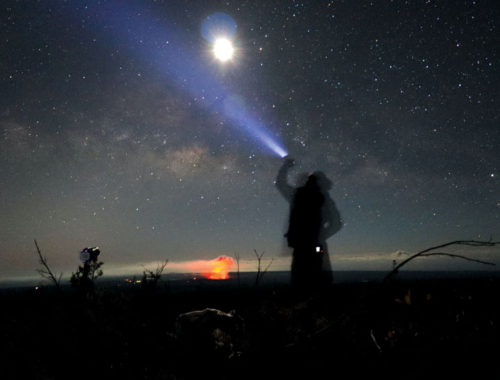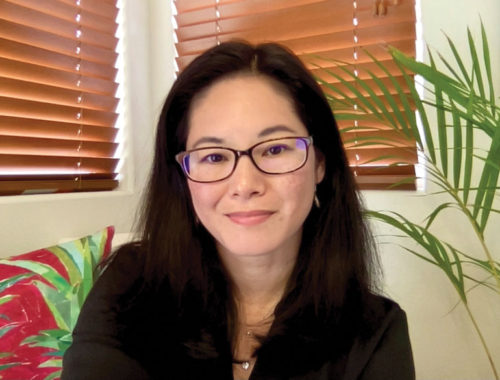
The Fate of Ahu‘ailā‘au ~ Shrine of the Forest Eater

By Stefan Verbano
Every footstep crunches on the way to the summit. A strange, brittle ash coats the land, heaped in golden hills in some places; in others cut away by rivulets of erosion from three years of tropical rainstorms.
The air is still foul with sulfur stink. Steam billows out of every crevice. Stop to take a breath—a pause in the crunching underfoot—until the smell of burning shoe soles warns that youʻve stumbled onto a still-hot patch of lavafield and itʻs time to keep moving. Once high up on the slopes, the steaming line of volcanic fissures from the 2018 Lower Puna Eruption, eerie in its absolute straightness, drifts into view between massive clouds of hot, humid haze swirling out of red cracks in the earth.
Suddenly, the wind rolling across this barren landscape changes direction and the all-engulfing blanket of steam disperses, allowing glints of sunlight to break through the cloudy sky and make the brown hills below glisten like theyʻre strewn with diamonds. The view becomes clear all around. Far in the distance the bank of the main lava channel, which moved billions of gallons of molten rock through Leilani Estates and sent it violently cascading downhill towards Kapoho in May 2018, cuts a sharp line against the forest behind it. The line meanders out toward the ocean on the horizon and then disappears.
At the top at last, the fissureʻs crest gives way to reveal its colossal interior. All at once thereʻs a culmination of every sensory stimuli from the hike up: the loose gravel tinkles like scattering glass, a blast of hot steam floats up out of the chasm and engulfs the whole body, strong sulfur fumes assault the nostrils, streaks of blinding sunlight weave their way through the steam and make the red walls and cracked black floor below sparkle vibrantly and illuminate the tufts of orange and white sprinkled throughout.
Tears fill stinging eyes as they finally take in the complete vista and behold such raw beauty dredged up from underground. Mesmerizing in its colorful splendor, unmatched in its natural majesty, dizzying in its sheer scale, the mighty Ahu‘ailā‘au towers over all else.
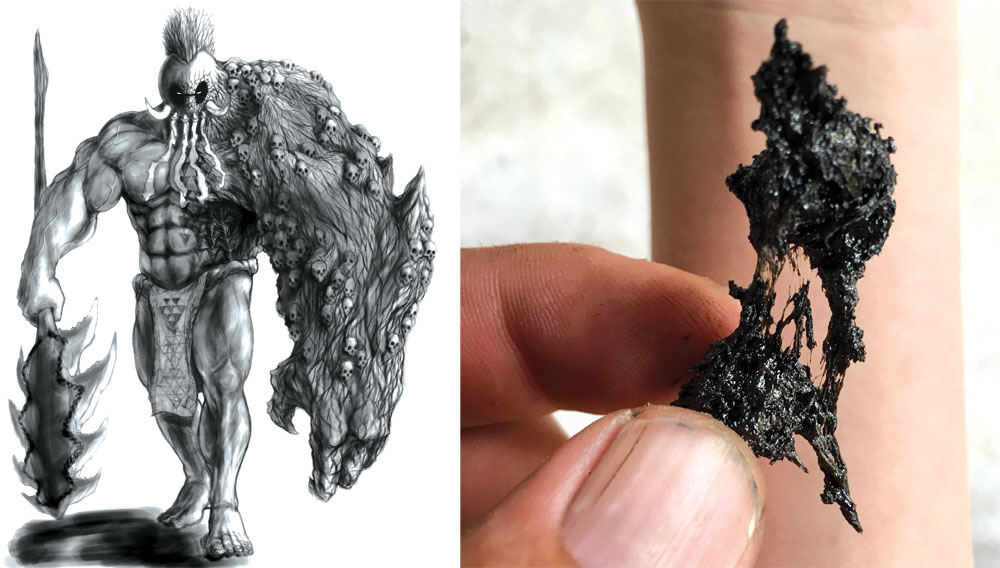
Whatʻs in a Name?
The 150-foot-tall oval-shaped fissure didn’t begin its life with such a colorful and meaningful a name as Ahu‘ailā‘au. In March 2021, the Hawai‘i Board of Geographic Names officially bestowed the mountain with a title befitting its majestic presence, selected from a list of 21 potential names submitted by the local community. Before then, it was simply known as “Fissure 8”—a dry, scientific designation denoting it was the eighth fissure to crop up during an eruption that went on to spawn 24.
In Hawaiian, Ahu means mound, shrine, or cairn, and ‘Ailā‘au is the name of an ancient male fire deity who is known to have inhabited a section of Kīlauea long ago. As the legend goes, upon Pele‘s arrival, ‘Ailā‘au slunk away from his crater in fear and was never heard from again. His name itself is comprised of Ai, meaning “the one who eats or devours” and Lā‘au, which can mean any plant growing from the earth; however, it commonly refers to a tree or forest. So, Ahu‘ailā‘au literally means: “Shrine of the Forest Eater.”
Some longtime residents deeply rooted in traditional Hawaiian culture who witnessed the 2018 flow said its lava didn’t feel the same as past eruptions theyʻd encountered; that it had a different smell or “force” or “energy”. They believe this is because the deity behind it wasn’t Pele. Even the official proposal to the naming board making the case for Ahu‘ailā‘au states that numerous cultural practitioners have relayed stories of being face-to-face with active lava in 2018 and experiencing “sightings, visions [of] and communication with ‘Ailā‘au.”

Differing Views
Even christened with a proper name and with its breathtaking beauty and uniqueness clear for all the world to see, the fate of Ahu‘ailā‘au still remains uncertain. Some Leilani Estates residents are clamoring for the subdivisionʻs lava-covered roads to be bulldozed open again—a move that some say would put the fissure system in grave danger—while others demand that the geological formations be preserved as cultural and scientific treasures. Itʻs a controversial issue that has divided the neighborhood, one side claiming property rights while the other extolls the sacredness and value of this new earth.
These two sides came to a dramatic showdown in December 2020. According to the island’s newspapers, one Leilani resident, Sam Estes, whose property along Luana Street contained a residence and ornamental plant farm before the flow, and now comprises part of the summit and slopes of Ahu‘ailā‘au, removed barricades installed by the neighborhood association and hired a bulldozer to clear 700 feet of lava-covered street all the way up to the fissureʻs base in order to access his land. Leaders of the association explicitly condemned Samʻs unilateral action.
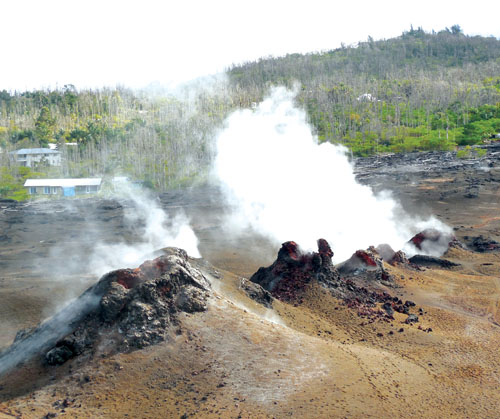
Some Leilani residents showed up that day to protest what they view as a desecration of hallowed ground. Among them was Clarity, an artist and community activist who declined to give her last name for this story. During those surreal weeks in 2018, Clarity witnessed Ahu‘ailā‘au burst through the earth, grow and transform into the soaring monolith it is today—an experience that bonded her to it, and drove her to its defense. Convinced that she was on the right side of history, she stood solemn and defiant in front of the bulldozer, blocking its path for a time that December day.
“A lot of the reason I feel this connection to it is because I watched it form,” she says. “There was nothing there; it was the coolest thing to see the Earth create something that was brand new. This mountain! It really was like watching the Earth give birth to a new creation…itʻs a birthing spot.”
This act of defiance, she says, was in recognition of how important the eruptionʻs creations like Ahu‘ailā‘au could be to the Hawai‘i Island community.
“I think there are so many undiscovered things in there; thereʻs caves and lava tubes and all kinds of interesting stuff,” Clarity says. “Itʻs not that I think nobody should be able to build roads back to their houses, itʻs just I think that itʻs worthy of somebody going in and really acknowledging what is there and what is unique about this place, and if we can somehow protect the things that are valuable to this whole island—to the people as a whole.”
In April 2021, Hawai‘i County began accepting applications for its Kīlauea Disaster Recovery Voluntary Housing Buyout Program. The kickoff came as a glimmer of hope for neighbors vying for the fissureʻs preservation, since under the programʻs rules the County would purchase land impacted by the 2018 eruption from willing owners at pre-disaster market values up to $230,000, demolish any existing structures on them, and then manage the combined area as open space in perpetuity with the possibility for limited agricultural use. Funding for the program comes from $84 million in federal disaster recovery funds distributed by the US Department of Housing and Urban Development (HUD).

What Are the Possibilites?
When thinking about what a preserved fissure system made up of bought-out parcels at the bottom of the subdivision could look like, Smiley Burrows, another Leilani resident and local activist, envisions a mini-volcano nature park complete with viewing platforms, hiking trails and amenities, and roads for alternative vehicles.
“It would be amazing to try to do some kind of integrated walking, biking, sightseeing road,” Smiley says. “Something that restricts automobiles completely, and where we can do horses and horse and buggies and bicycles and maybe even electric golf cart-kine things.”
Such a park would allow residents and visitors to experience the fissures culturally, spiritually, and scientifically, she says, and create a tourism draw that could go a long way in rehabilitating Puna Districtʻs long-suffering economy.
“An opportunity like that would help bring it back from being a ghost town,” Smiley says about Pāhoa. “It would offer opportunities for employment; it would reestablish functionality in our town…yeah, it would bring our town back to life. Itʻs very doable.”
Donna Walker and her large family have two acres of land on the other side of Luana Street from Sam, which are also now part of the summit and slopes of Ahu‘ailā‘au. From the time she was a little girl growing up in Puna, Donna was instilled with the classic Hawaiian ethos of mālama ka ‘āina (care for the land).
“We learned early on from our kūpuna [elders] and our kūmu [teachers] that property didnʻt belong to us,” Donna says. “We didn’t really ‘ownʻ it. We were being entrusted with it.”
When asked about her willingness to take the housing buyout for her inundated land, she answers with an emphatic yes. “For us, it’s like: we can’t be there anymore. So, what are we going to do with it?” she says. “Let’s preserve it for our kids—let’s preserve it for their kids.”
For now, it seems the fate of ‘Ailā‘au’s mighty shrine rests in the hands of Leilani Estates neighbors, or possibly ‘Ailā‘au himself. ❖

